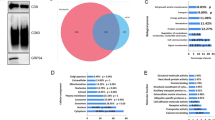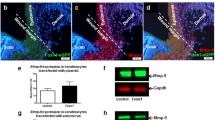Abstract
The ability of glutathione to affect melanocyte survival has fostered its use in a variety of applications related to epithelial cells. Our study focused on fibroblast migration and the effects of oxidative stress. We used scratch assays to measure cell migration: fibroblasts were harvested from embryonic chicks, grown to confluence in a monolayer, and the layer was scratched to initiate migration. Migration rates were measured over 8 h using photomicrographs, and vinculin expression as an indicator focal adhesion formation was measured using immunofluorescence. Addition of 200 μM glutathione to the culture media in which the cells grew resulted in a significantly increased rate of scratch closure. When the scratch assays were performed in the presence of 100 μM H2O2 (to simulate oxidative stress), the cells ceased to migrate. Addition of 200 μM glutathione to the H2O2-treated scratched layers resulted in a restoration of the scratch closure capabilities. At the subcellular level, addition of extracellular glutathione resulted in a redistribution of vinculin into fewer but larger aggregates. In cells at the edge of scratched monolayers that were treated with H2O2, vinculin particles were distributed throughout the cell in smaller aggregates; addition of glutathione resulted in vinculin aggregates that were larger and closer to the edges of the cell, indicating that these cells were more migratory. Our results suggest that glutathione promotes fibroblast migration, possibly via a mechanism that promotes the formation of focal adhesions.




Similar content being viewed by others
References
Alena F.; Dixon W.; Thomas P.; Jimbow K. Glutathione plays a key role in the depigmenting and melanocytotoxic action of N-acetyl-4-S-cyteaminylphenol in black and yellow hair follicles. J. Invest. Dermatol. 104: 792–797; 1995.
Bradley R. A.; Couchman J. R.; Rees D. A. Comparison of the cell cytoskeleton in migratory and stationary chick fibroblasts. J. Musc. Res. Cell. Motil. 1: 5–14; 1980.
Burridge K.; Fath K.; Kelly T.; Nuckolls G.; Turner C. Focal adhesions: transmembrane junctions between the extracellular matrix and the cytoskeleton. Annu. Rev. Cell. Biol. 4: 487–525; 1988.
Buschmann H. J.; Schollmeyer E. Applications of cyclodextrins in cosmetic products: a review. J. Cosmet. Sci. 53: 185–191; 2002.
Chen Q. M.; Tu V. C.; Catania J.; Burton M.; Toussaint O.; Dilley T. Involvement of Rb family proteins, focal adhesion proteins and protein synthesis in senescent morphogenesis induced by hydrogen peroxide. J. Cell. Sci. 113: 4087–4098; 2000.
Chow C. K.; Tappel A. L. An enzymatic protective mechanism against lipid peroxidation damage to lungs of ozone-exposed rats. Lipids 7: 518–524; 1972.
Colston J. T.; Rosa S. D.; Freeman G. L. Impact of brief oxidant stress on primary adult cardiac fibroblasts. Biochem. Biophys. Res. Comm. 316: 258–262; 2004.
Dröge W.; Breitkreutz R. Glutathione and immune function. Proc. Nutr. Soc. 59: 595–600; 2000.
Dunleavy J. R.; Couchman J. R. Controlled induction of focal adhesion disassembly and migration in primary fibroblasts. J. Cell. Sci. 105: 489–500; 1993.
Engelmann J.; Janke V.; Volk J.; Leyhausen G.; Von Neuhoff N.; Schlegelberger B.; Geurtsen W. Effects of BisGMA on glutathione metabolism and apoptosis inhuman gingival fibroblasts in vitro. Biomaterials 25: 4573–4580; 2004.
Gotti R.; Andrisano B.; Cavrini V.; Bongini A. Determination of glutathione in pharmaceuticals and cosmetics by HPLC with UV and fluorescence detection. Chromatographia 39: 23–28; 1994.
Gregersen N.; Bross P. Protein misfolding and cellular stress: an overview. Method Mol. Biol. 648: 3–23; 2010.
Gurtner G. C.; Werner S.; Barrandon Y.; Longaker M. T. Wound repair and regeneration. Nature 453: 314–324; 2008.
He Y.; Huang J.; Ramirez D. C.; Chignell C. F. Role of reduced glutathione efflux in apoptosis of immortalized human keratinocytes induced by UVA. J. Biol. Chem. 278: 8058–8064; 2003.
Holmgren A. Glutathione-dependent synthesis of deoxyribonucleotides. Characterization of the enzymatic mechanism of Escherichia coli glutaredoxin. J. Biol. Chem. 254: 3672–3678; 1979.
Kalebic T.; Kinter A.; Poli G.; Anderson M. E.; Meister A.; Fauci A. S. Suppression of human immunodeficiency virus expression in chronically infected monocytic cells by glutathione, glutathione ester, and N-acetylcysteine. Proc. Natl. Acad. Sci. U.S.A. 88: 986–990; 1991.
Kim W.-S.; Park B.-S.; Kim H.-K.; Park J.-S.; Kim K.-J.; Choi J.-S.; Chung S.-J.; Kim D.-D.; Sung J.-H. Evidence supporting antioxidant action of adipose-derived stem cells: protection of human dermal fibroblasts from oxidative stress. J. Dermatol. Sci. 49: 133–142; 2008.
Kopal C.; Deveci M.; Öztürk S.; Sengezer M. Effects of topical glutathione treatment in rat ischemic wound model. Ann. Plastic Surg. 58: 449–455; 2007.
Lai G.; Ozols R. F.; Young R. C.; Hamilton T. C. Effect of glutathione on DNA repair in cisplatin-resistant human ovarian cancer cell lines. J. Natl. Cancer. Inst. 81: 535–539; 1989.
Liang C.-C.; Park A. Y.; Guan J.-L. In vitro scratch assay: a convenient and inexpensive method for analysis of cell migration in vitro. Nat. Protoc. 2: 329–333; 2007.
Loo A. E. K.; Ho R.; Halliwell B. Mechanism of hydrogen peroxide-induced keratinocyte migration in a scratch-wound model. Free Rad. Biol. Med. 51: 884–892; 2011.
Marionnet C.; Pierrard C.; Lejeune F.; Sok J.; Thomas M.; Bernerd F. Different oxidative stress response in keratinocytes and fibroblasts of reconstructed skin exposed to non extreme daily-ultraviolet radiation. PLoS ONE 5: e12059; 2010.
Martin P.; Parkhurst S. M. Parallels between tissue repair and embryo morphogenesis. Development 131: 3021–3034; 2004.
Matsubayashi Y.; Ebisuya M.; Honjoh S.; Nishida E. ERK activation propagates in epithelial sheets and regulates their migration during wound healing. Curr. Biol. 14: 731–735; 2004.
Mocali A.; Caldini C. R.; Chevanne M.; Paoletti F. Induction, effects, and quantification of sublethal oxidative stress by hydrogen peroxide on cultured human fibroblasts. Exp. Cell. Res. 216: 388–395; 1995.
Nevin K. G.; Rajamohan T. Effect of topical application of virgin coconut oil on skin components and antioxidant status during dermal wound healing in young rats. Skin Pharmacol. Physiol. 23: 290–297; 2010.
Niggli H. J.; Applegate L. A. Glutathione response after UVA irradiation in mitotic and postmitotic human skin fibroblasts and keratinocytes. Photochem. Photobiol. 65: 680–684; 1997.
Nobes C. D.; Hall A. Rho, rac, and cdc42 GTPases regulate the assembly of multimolecular focal complexes associated with actin stress fibers, lamellipodia, and filopodia. Cell 81: 53–62; 1995.
O’Toole E. A.; Goel M.; Woodley D. T. Hydrogen peroxide inhibits human keratinocyte migration. Dermatol. Surg 22: 525–529; 1996.
Orkin R. W.; Toole B. P. Isolation and characterization of hyaluronidase from cultures of chick embryo skin- and muscle-derived fibroblasts. J. Biol. Chem. 255: 1036–1042; 1980.
Ridley A. Rho GTPases and cell migration. J. Cell. Sci. 114: 2713–2722; 2001.
Rifkin D. B.; Crowe R. M. Tumor promoters induce changes in the chick embryo fibroblast cytoskeleton. Cell 18: 361–368; 1979.
Schäfer M.; Werner S. Oxidative stress and normal and impaired wound repair. Pharmacol. Res. 58: 165–171; 2008.
Shen H.-M.; Liu Z. JNK signaling pathway is a key modulator in cell death mediated by reactive oxygen and nitrogen species. Free Radic. Biol. Med 40: 928–939; 2006.
Shukla A.; Rasik A. M.; Patnaik G. K. Depletion of reduced glutathione, ascorbic acid, vitamin E and antioxidant defence enzymes in a healing cutaneous wound. Free Radic. Res. 26: 93–101; 1997.
Steiling H.; Munz B.; Werner S.; Brauchle M. Different types of ROS-scavenging enzymes are expressed during cutaneous wound repair. Exp. Cell Res. 247: 484–494; 1999.
Takahashi M.; Nagai T.; Hamano S.; Kuwayama M.; Okamura N.; Okano A. Effect of thiol compounds on in vitro development and intracellular glutathione content of bovine embryos. Biol. Reprod. 49: 228–232; 1993.
Tyrrell R. M.; Pidoux M. Endogenous glutathione protects human skin fibroblasts against the cytotoxic action of UVB, UVA and near-visible radiations. Photochem. Photobiol. 44: 561–564; 1986.
Veal E. A.; Day A. M.; Morgan B. A. Hydrogen peroxide sensing and signaling. Molec. Cell 26: 1–14; 2007.
Vessey D. A.; Lee K. Inactivation of enzymes of the glutathione antioxidant system by treatment of cultured human keratinocytes with peroxides. J. Invest. Dermatol. 100: 829–833; 1993.
Vessey D. A.; Lee K.; Blacker K. L. Characterization of the oxidative stress initiated in cultured human keratinocytes by treatment with peroxides. J. Invest. Dermatol. 99: 859–863; 1992.
Villarama C. D.; Maibach H. I. Glutathione as a depigmenting agent: an overview. Int. J. Cosmet. Sci. 27: 147–153; 2005.
Wall I. B.; Moseley R.; Baird D. M.; Kipling D.; Giles P.; Laffafian I.; Price P. E.; Thomas D. W.; Stephens P. Fibroblast dysfunction is a key factor in the non-healing of chronic venous leg ulcers. J. Invest. Dermatol. 128: 2526–2540; 2008.
Werner S.; Krieg T.; Smola H. Keratinocyte–fibroblast interactions in wound healing. J. Invest. Dermatol. 127: 998–1008; 2007.
Yohn J. J.; Norris D. A.; Yrastorza D. G.; Bruno I. J.; Leff J. A.; Hake S. S.; Repine J. E. Disparate antioxidant enzyme activities in cultured human cutaneous fibroblasts, keratinocytes, and melanocytes. J. Invest. Dermatol. 97: 405–409; 1991.
Author information
Authors and Affiliations
Corresponding author
Additional information
Editor: T. Okamoto
Rights and permissions
About this article
Cite this article
DeNunzio, M., Gomez, G. Extracellular glutathione promotes migration of hydrogen peroxide-stressed cultured chick embryonic skin cells. In Vitro Cell.Dev.Biol.-Animal 50, 350–357 (2014). https://doi.org/10.1007/s11626-013-9696-z
Received:
Accepted:
Published:
Issue Date:
DOI: https://doi.org/10.1007/s11626-013-9696-z




